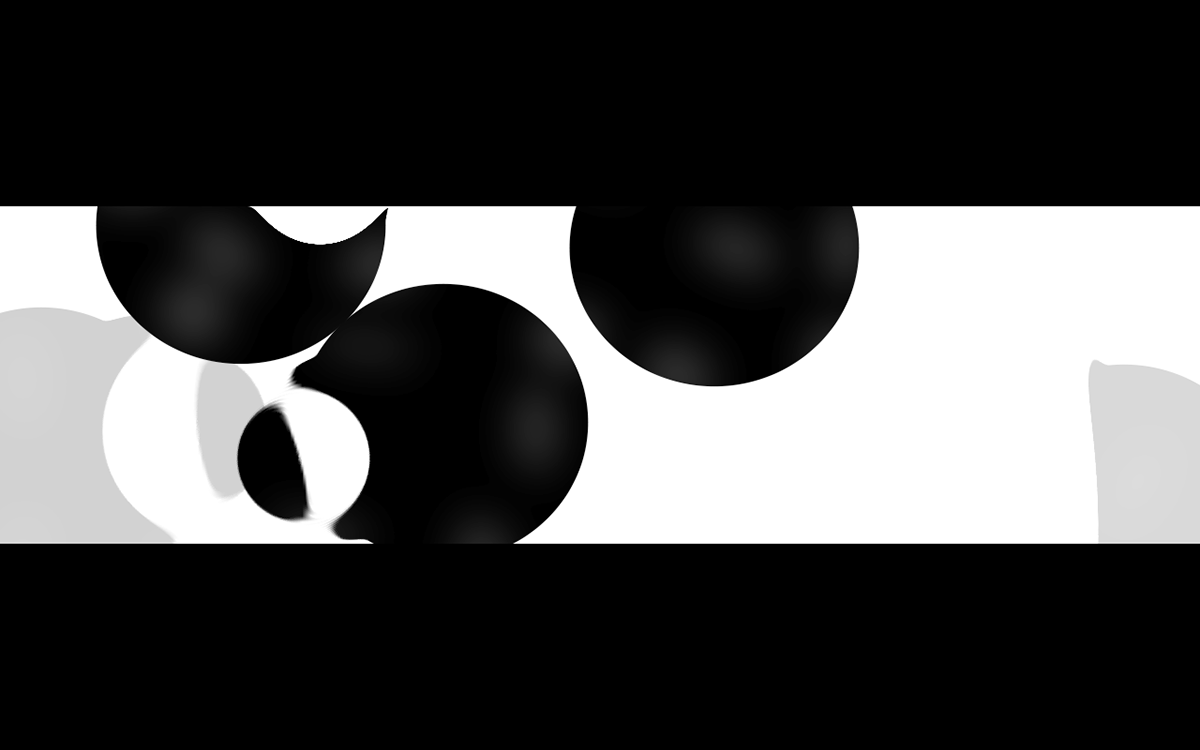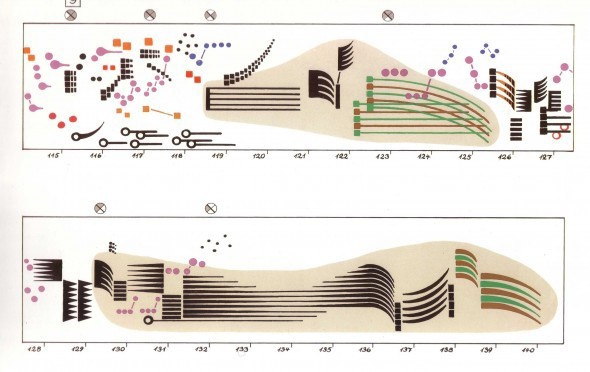
Thesis Statement
Creating an interaction between sonic and visual information can yield something far more interesting. My goal is to design a graphic score for musicians to respond to spontaneously. The score is an abstract system of animated notation. The majority of the score will allow for their own interpretation. There will be groups of musicians who will perform this score while I record them. Once I have all of the recordings, I will visualize the sonic data.
Animation Screenshots



The goal of this project is to show how fascinating the relationship sonic and visual information share. Each of them are very much related and benefit from each other. Imagine there is a painter and a guitarist in an empty room. Both of them have the ability to paint a melody off the cuff even though one has a palette and the other, six strings.
Research Imagery

Cornelius Cardew - Treatise

Oliver Coates
During the research process I was very surpised and excited by my discoveries. I learned there are many other artists and composers that have composed their own graphic scores or abstract notation. This part of the process helped me eliminate possibilities of creating similar compositions. Through much exploration I decided to create an animated graphic score. Through my research I realized no one has created an animated graphic notation, so I went in that direction.

Ben Van Dyke
Ben Van Dyke is not a musician/composer but I discovered his work to be very musical and a source of inspiration for my own work.

Leo Smith -

Tom Phillips’ - ‘Ornamentik’

John Cage

Anthony Braxton - What I Call Sound
Sketching Process
Once I gathered enough research I began sketching out ideas for the graphic score. The decision to compose an animated graphic score did not arrive until later in the sketching process.
Below are some beginning sketches.





Animating The Sound.
After a lengthy sketching process I created an additional step. I composed a song that the animation will respond to. So what I did was export each track(stems) of the song and convert the audio into "key frames" in Adobe After Effects. This means that the audio information of either the "drum track" or the "bass track" are assigned to a shape in After Effects that responds to the dynamics of what ever track is assigned.
Recording The Response
The process and experience of recording the musicians responding spontaneously to the animation was incredibly encouraging. The beginning stages of this project hit so many dead ends and I was loosing faith until this part of the process. Not one of the responses was the same. Some of the musicians I recorded were two trumpet player and their responses were incredibly different.
After the recording process, one of the drummers I recorded said," This has changed the way I play, I am going to think more "visual" when I play now." That is exactly what I set out to achieve. Thinking unconventionally and metaphorically helps expand the creative spirit. I want musicians to see their compositions as a canvas filled with contrast, dynamics, color, texture, depth, etc. I feel the same way about visual artists as well. I want visual artists to imagine their compositions have crescendos, tempo change, syncopation, harmony, etc.
After the recording process, one of the drummers I recorded said," This has changed the way I play, I am going to think more "visual" when I play now." That is exactly what I set out to achieve. Thinking unconventionally and metaphorically helps expand the creative spirit. I want musicians to see their compositions as a canvas filled with contrast, dynamics, color, texture, depth, etc. I feel the same way about visual artists as well. I want visual artists to imagine their compositions have crescendos, tempo change, syncopation, harmony, etc.
Sources
Graphic scores: lively alternative ways of writing down music.
http://www.ft.com/intl/cms/s/2/7b14f656-243d-11e3-8905-00144feab7de.html#axzz3xhsuYAn2
Graphic Scores - Celebrating the art of music
http://www.sagegateshead.com/event/graphic-scores/
Picturing Music: The Return of Graphic Notation
http://www.newmusicbox.org/articles/Picturing-Music-The-Return-of-Graphic-Notation/
Art and music collide in these 20 stunning graphic scores
http://www.classicfm.com/discover/music/graphic-scores-art-music-pictures/schnee-chollobhat/
Moving Forms: Writings on Graphic Notation
http://post.at.moma.org/content_items/483-moving-forms-writings-on-graphic-notation
Treatise Cornelius Cardew
http://www.blockmuseum.northwestern.edu/picturesofmusic/pages/anim.html
Ben Van Dyke
http://benjaminvandyke.com/index.php?/3d/improv-at-san-diego-state-univ/
From Neumes to Notes: The Evolution of Music Notation
http://digitalcommons.cedarville.edu/cgi/viewcontent.cgi?article=1031&context=musicalofferings
The History and Evolution of the Musical Symbol
http://www.thisisgabes.com/images/docs/musicsymbol.pdf
http://tricentricfoundation.org/all-scores
Visual Sounds: Graphic Notation in Theory and Practice
https://iasext.wesleyan.edu/regprod/!wesmaps_page.html?crse=013535&term=1131
Scoring Outside the Lines
http://opinionator.blogs.nytimes.com/2011/08/03/scoring-outside-the-lines/?_r=0
Cornelius Cardew & The Scratch Orchestra - The Great Learning (Paragraph 1)
https://www.youtube.com/watch?v=2k1m1ITcljM

